Leather Education & Community Links:
Wearing Leather:

Beyond the sensual masculine appeal of leather, wearing leather boots, accessories and gear is an expression of ones identity with the leather community.
The gay male leather culture began to emerge in the late 1940’s out of the post-WWII biker culture. Motorcycle events provided a way for interested gay men to meet each other at a time when being gay was still considered a crime in most countries, punishable by years in prison or even execution.
The 1953 outlaw biker film The Wild One, starring Marlon Brando, played on pop-cultural fascination with the July 1947 Hollister “riot” and promoted an image of wearing black leather jackets, a black leather cap, black leather boots and jeans as an appealing alternative to the pervasive effeminate stereotype of gay men. Photographs published by English photographer Tom Nicoll and drawings published by Tom of Finland beginning in the mid-1950’s helped to further define the image of gay biker leathermen.
Leather gear generally continues to follow the image of the post-WWII biker culture, with influence from military uniforms, law enforcement uniforms and the old west. Leather gear for motorcyclists has continued to be readily available since the 1940’s, leather gear provides protection. In the earliest years leather gear could be either black or dark brown following original service uniform leather, black quickly emerged as the most popular color of leather boots and gear worn in the emerging gay leather community.
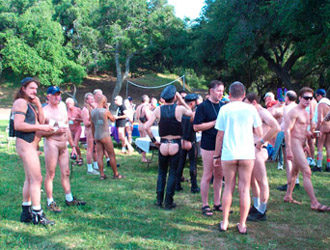
Protocols developed during the 1950’s, helping leathermen express their identity with the leather community, identify like minded men, develop interpersonal connections and establish the social order within the leather community. The emerging protocol also defined how Masters/Sirs and boys/submissives dress in leather settings helping leathermen express their identity and level of experience. Someone who didn’t dress following the protocol was commonly perceived as an outsider. Protocol and traditions often varied somewhat by city or region. These protocols for wearing leather included:
- Always wear boots, military or motorcycle style, preferably black.
- Always wear a wide leather belt, plain, not fancy.
- Never mix brown leather with black leather.
- Never mix chrome or silver trim with gold or brass trim.
- Long pants only, Levis or leather, no shorts.
- Chaps indicate more commitment than Levis, and leather pants indicate more commitment than chaps.
- Leather jacket must have epaulets ( and exception was made for motorcycle riders).
- Head gear is reserved for Tops or experienced bottoms only.
- Bottoms may not own collars, a Top may allow them to be the custodian of a collar owned by the Top.
- A bottom wearing a collar is owned by the Top that owns the collar, other Tops are not to engage a collared bottom in conversation, but other bottoms may do so.
- Never touch the bill of a bike cap (cover), including your own.
- Never touch another man’s cap (cover) unless you are very intimate frients or lovers.
- Leather other than boots and a belt must be earned as a rite of passage as one gained experience and knowledge.
- Wearing gloves is reserved for heavy players, glove fetishists or biker riders.
- Indicate SM preference, keys left for Top, keys right for bottom. Those who switch are second class players and not to be taken seriously.
- Full leather is reserved for after 10:00 p.m. and only with “our own kind.”1
As the gay leather community grew, leather specialty shops began to create and sell leather fetish gear for a more specific kinky nature. One of the first was The Leathermaker which opened on Melrose in Los Angeles in 1960. Today leather shops are available on most major U. S. cities, some also sell online. Leather garments purchased in a store can be tried on, altered where needed or custom made to ensure it fits correctly. Leather quality varies, shops offering custom made goods typically use the best quality leather.
Leather gear gradually evolved beginning in the mid-1970’s and continuing through subsequent decades, influenced by a growing sense of freedom, emerging national and international leather community events, publications such as Drummer Magazine, and new offerings from leather shops and manufactures. Today leatherfolk have a wider range of choices of what to wear while still honoring the core leather traditions.
Boots:
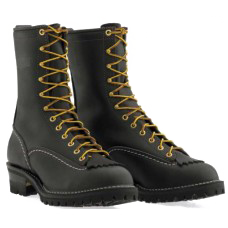
Plain black leather military or motorcycle boots are the foundation of leather gear. Boots are considered essential, even if you are otherwise naked.
There are two general categories of boots:
- Lace-up motorcycle or work boots such as military combat boots, logger boots, linesman boots or law enforcement boots are the most versatile and can be worn with or without full length pants.
- Pull on motorcycle boots such as harness boots, patrol boots or engineer boots are best worn with full length pants. Patrol boots or engineer boots are ideal with leather uniforms. In some parts of the country black cowboy boots are also worn.
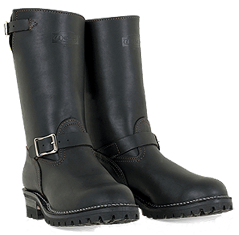
Boots can be oil-tanned with a matte finish, or smooth-finished with a polished satin or a glossy finish. Oil-tanned leather has a distinctive natural look and feel, and is exceptionally durable. It is water, stain, and perspiration resistant and is popular with motorcycle riders and workers. Smooth-finished leather has a polished surface that showcases its beauty and quality popular with uniform and formal wear, however, it requires more care and attention to maintain. All boots should be kept clean, conditioned and polished as appropriate for the leather, information on leather care is available from most boot manufactures and can also be found at the bottom of this page. Bootblacks are available at some leather bars and events to clean, shine and care for boots for a small fee.
Popular boot manufactures include: Wesco, Dehner, Danner, White’s, Carolina, Red Wing, All American, Dr. Martens and Wolverine. These manufactures all offer black leather work or motorcycle boots as described above, most offer high quality boots made in the United States or United Kingdom. Boots can be purchased from local retail stores where they can be tried on to ensure a correct fit, or from on-line retailers (keep in mind that sizes vary between manufactures).
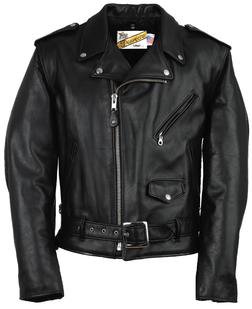
Casual leather attire or gear:
Casual leather is typically worn at leather bars, festivals, club events and other informal activities. Some guys wear the leather basics as daily casual wear. Casual leather typically includes the following basics:
- A black leather motorcycle jacket is also a basic in colder weather. The movie The Wild One, featured Marlon Brando perched on his motorcycle wearing his Schott Perfecto® motorcycle jacket, boots and jeans in 1953, helped establish the style standard among men adopting a leather look and lifestyle.
- A wide plain or basket weave black leather belt is also a basic (assuming pants are being worn).
- In the U. S. classic blue (or black) denim jeans, such as Levi’s® 501® jeans, are commonly worn for casual wear, traditionally jeans were in good repair and not faded. During the mid-1970 faded snug fitting jeans became popular in both the leather and general gay men’s community and continue to be popular. In Europe leather pants are typically worn, leather pants have become more popular in the U. S. in recent years. Leather shorts are now an option for casual wear. Traditionally a jock can be worn underneath if needed, but not underwear.
- A t-shirt or tank-top may be worn when a shirt is desired or required. Following some early traditional protocols solid black is preferred for Dominants, white is preferred for submissives, black may also an option for submissives in some areas, grey became an option by the mid-1980’s. Today, while white may still be preferred for submissives, solid color, club or event t-shirts are commonly worn, uniform colors. A denim work shirt is as an alternative for casual wear.
- Keys worn on the left signify a man who identifies himself as a Dominant or Top, and on the right by a man who identifies himself as a submissive or bottom.
- Smell and feel natural always avoid wearing cologne at leather bars or events, guys enjoy the natural smell of leather and men. Cologne is not part of the leather image and can damage leather. Deodorant is also discouraged, some event hosts specify no deodorant in the announcements. Guys prefer to shower and be clean and smell natural. Some guys believe they need deodorant when not otherwise prohibited, if worn, stick with an unscented natural deodorant used very sparingly so it isn’t noticeable. Some deodorants may also damage leather.
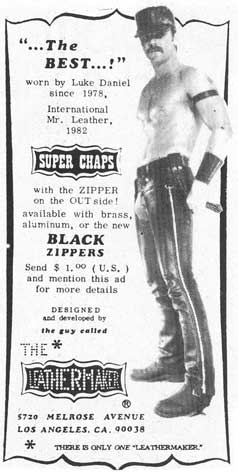
Additional Casual leather gear was traditionally earned one piece a time as one gained experience and knowledge. Additional casual leather may also include:
- A black leather vest might replace a jacket in warmer weather, open “bar vests’ which don’t completely cover the chest are generally preferred, although biker vests which close can also be worn. The back side of a vest is traditionally reserved for a leather/motorcycle club member patch or leather community title-holder patch.
- A leather harness has become a popular optional part of leather gear in more recent years, may be worn when one isn’t wearing a shirt. Harnesses including chain are also an option. Shirtless is typically a popular option in bars and at casual events. Harnesses are also functional for leather play. Traditionally chest or upper body only harnesses were preferred by Dominants, harnesses which extended below the waist were most commonly worn by submissives. Today newer style harnesses, such as a bulldog harness, may be worn by both.
- a leather jock or T-back, worn when one isn’t wearing pants.
- leather chaps, typically worn over blue jeans but can alternatively be worn with a leather jock or T-back (chaps designed primarily for bar and leather community event wear are typically more form fitting than those designed for motorcycle wear).
- a leather or cotton-poly utility kilt may be worn as an alternative to pants or jeans.
- a leather cap (also knows as a cover) may also be worn, styles include Muir caps (in some traditions Muir caps are only worn by Dominants), military style caps, law enforcement style caps and baseball style caps. In some parts of the country black western style hats may also be worn.
- a leather armband or a leather wrist band worn on the left signify a man who identifies himself as a Dominant or Top, and on the right by a man who identifies himself as a submissive or bottom.
- A color handkerchief may be worn, typically in a back pocket, to express more specific interests following a hanky code, following the same left Dominant, right submissive practice.
- Specific fetish items may be worn to indicate an interest in a specific fetish following the same left Dominant, right submissive practice, for example wearing handcuffs could express an interest in bondage, a puppy hood would expresses an interest in puppy play, or a flogger could express an interest in flogging.
- A collar may be presented to and worn by a submissive in a BDSM relationship to symbolize their status.
Formal leather attire:
Formal leather attire typically follows the style of a traditional military or law enforcement uniform, including:
- a leather uniform shirt (black or in uniform colors);
- leather pants or breeches;
- a Muir Cap (in some traditions these were only worn by Dominants) or other uniform style leather cap (cover);
- leather law enforcement or Sam Browne belt;
- a leather military or law enforcement style jacket;
- a leather kilt may be worn as an alternative to pants or jeans following Scottish, Irish, English or Roman military traditions;
- leather gloves and a leather tie are typically optional.
A special event may may require formal leather or other specific attire. Ask the host ahead of time if you aren’t sure what is appropriate.
Getting Started:
Stick with the basics when starting to visit leather bars and attend leather community events. It is best to be honest and start out slowly. Black leather boots should be the fist leather purchased, lace up boots offer the most versatility, 8 to 10 inch tall lace up boots are the most commonly worn in the leather community. It is best to purchase boots that you can try on first at a local store to ensure the correct fit, as sizes do vary. If your only option is to purchase online ensure that the purchaser accepts exchanges and returns. Purchase the best quality leather boots you can comfortably afford. Add a black leather belt to your blue (or black) denim jeans and you should fit right in. A leather harness has also become a popular optional basic purchase for wear when not wearing a shirt.
Remember that in traditional leather culture leathers were typically earned one piece a time as a rite of passage, it is best to treat your next purchase with the same respect.
While not endorsed by CMEN, a partial list of leather shops is provided for your convenience. Some local leather clubs hold leather swap meats which present an opportunity to purchase used leather gear at a fraction of the price of new leather gear. Thrift stores can also be source of used leather motorcycle jackets, boots and other items.
Additional Information:
- Exploring the Gay Leather Community
- Gay Leather Community Events and Organizations
- Wearing Leather
- Leather Care
- Leather Shops
- Handkerchief Codes
- Exploring Kink
- Mr. CMEN Leather
1 Baldwin, Guy. Ties that Bind; SM / Leather / Fetish Erotic Style; Issues, Commentaries and Advice. 2nd Edition, 2003, Daedalus Publishing Company, Los Angeles. ISBN 1-881943-09-7, pp 111-112.
Trust, Honor and Respect
Information on this page is from the Leather 101 workshop at the West Coast Gathering, September 2018, presented by Rick B. Mr CMEN Leather 2015.
Information on this page is provided for educational purposes and does not imply endorsement by CMEN. Please note that CMEN does not control the content of linked web sites, the organizations who own these web sites accept sole responsibility for their content.
Exploring the Leather Community – Leather Events and Organizations – Wearing Leather – Leather Care – Leather Shops – Hanky Code – Exploring Kink

